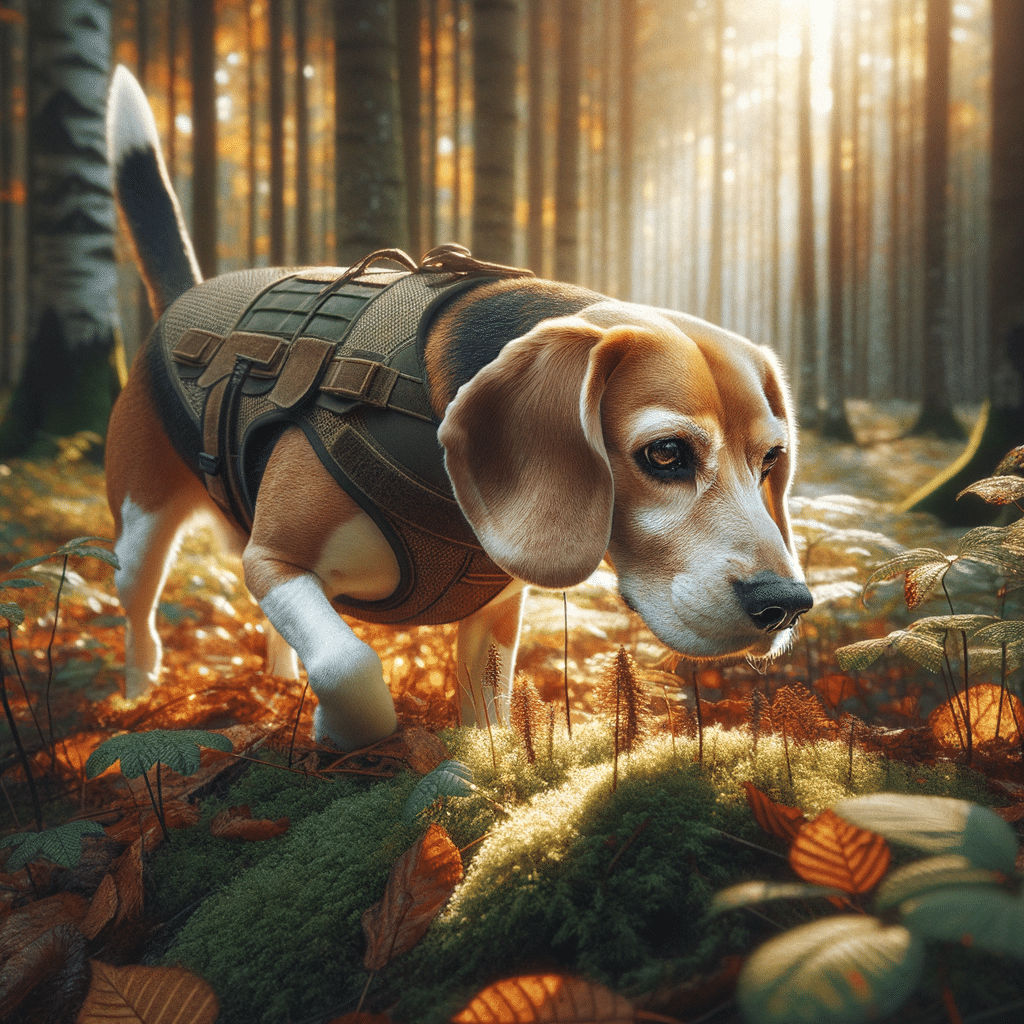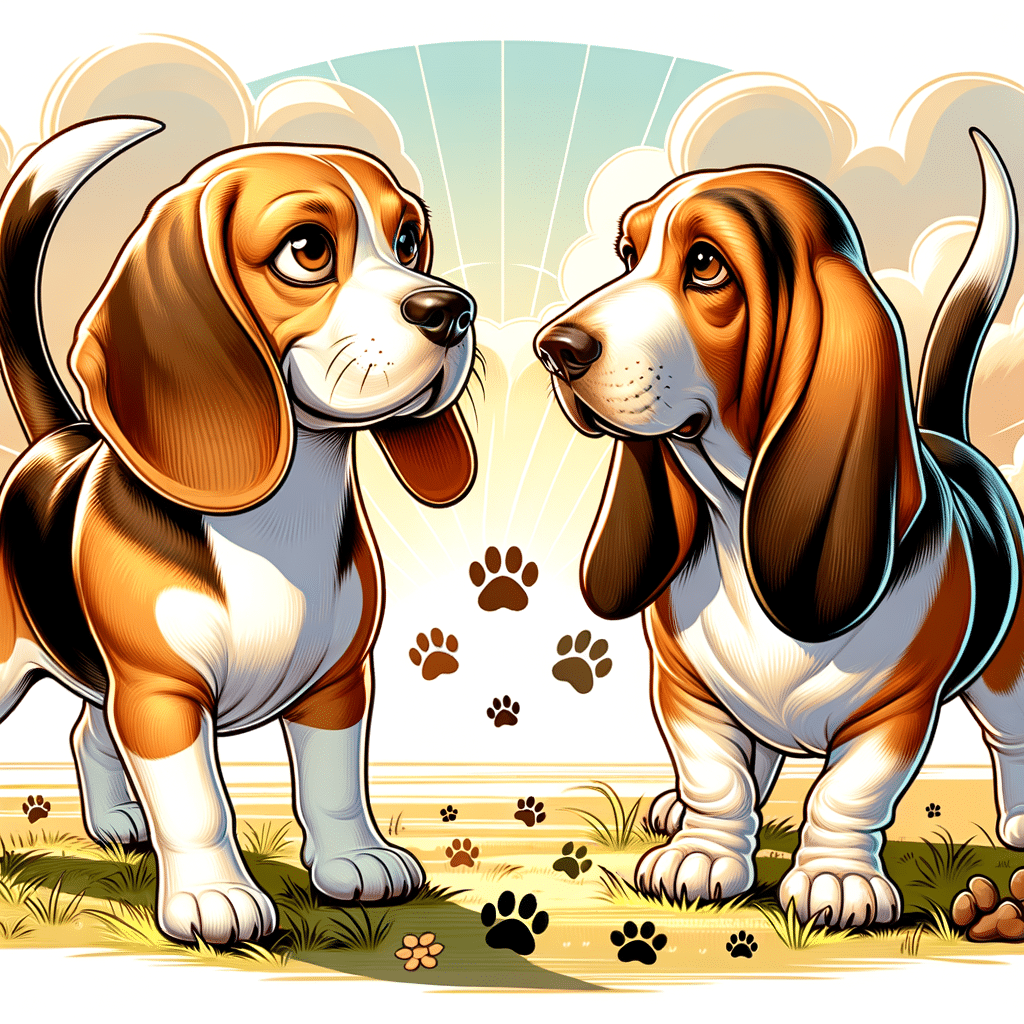If you’re considering adding a furry friend to your family, choosing the right breed is essential. Beagles and bloodhounds, each with a strong sense of smell, offer unique traits that suit different lifestyles and preferences. While they share a common ancestry in hunting, their histories caused them to evolve into breeds with unique features.
In This Article
Beagles are small and live from 10 to 15 years; because of their size and energy levels, they are a good fit for active families. Bloodhounds, known for their impressive tracking abilities, are larger and more powerful but typically have a shorter lifespan due to their size.
Keep reading to learn more about the differences and similarities between these two popular dog breeds.
You can observe the subtle and not-so-subtle differences between the beagle and bloodhound breed in their care and mood. Beagles are low-shedding dogs with moderate maintenance needs; bloodhounds are also surprisingly low-maintenance despite their larger size. However, these breeds have very different personalities. Beagles are often joyful and adventurous, thriving in a family environment, while bloodhounds are more independent and known for their determination and amazing scent-tracking abilities.
Potential owners should consider these characteristics, as well as health needs and dog grooming requirements, to determine which breed best fits their lifestyle. Additionally, make sure to research both breeds to find out if you can meet the long-term care needs of your future family member.
Highlights
- Beagles and bloodhounds have different sizes, lifespans, and maintenance needs.
- Each breed has distinct moods; beagles are more family-friendly, and bloodhounds are more independent.
- Choosing between these breeds requires considering their physical and personality characteristics, as well as their health and care requirements.
Breed Origins and History
Both beagles and bloodhounds are popular dog breeds with rich histories connected to their pasts as European hunting dogs. They have unique lineages greatly influenced by their countries of origin.
Beagle History
The beagle’s roots can be traced back to England, where the breed evolved from ancient hounds. In England, they were refined for hunting small game due to their keen sense of smell and tracking ability.
The name ‘beagle’ is believed to derive from the French word ‘be’geule,’ which references their loud baying. Historically, these hounds were prized for their ability to hunt in packs and were popular among British nobility.
Bloodhound History
Originating from Belgium, the bloodhound is known as the Chien de Saint-Hubert in its native country. Bloodhounds were imported to France in the 19th century to rebuild the St Hubert Hound line, solidifying its status as an ancestor and descendant within the hound group.
Bloodhounds are known for their scenting skills and have a legacy of tracking and hunting big game. Although their name may suggest a fierce nature, these hound dogs are known for being very gentle. In addition to France and Belgium, Britain also claims the bloodhound as a native breed prominent in English and European canine history.
Physical Characteristics
The physical characteristics of beagles and bloodhounds distinctly reflect their historical roles as hunting dogs. Each breed displays unique features suited to its specialized tracking abilities.
Beagle’s Appearance
Beagles are small to medium-sized dogs well-known for their compact, muscular build. Typically, a beagle’s height ranges from 13 to 15 inches at the shoulder. Their weight is generally between 20 and 30 pounds. They have a smooth coat that is easy to groom. Coat colors include tri-color (black, white, and tan), red and white, or lemon and white. Beagles are known for their large brown or hazel eyes and long, hound-like ears that hang down.
- Size: Small to medium
- Coat: Short, smooth, weather-resistant
- Ears: Long, pendant
- Colors: Tri-color, red and white, lemon and white
- Grooming needs: Low
Bloodhound Appearance
Bloodhounds are significantly larger than beagles, reaching 23 to 27 inches at the withers and weighing between 80 and 110 pounds. They have distinctive coats in colors like black and tan, liver and tan, or red. This breed’s coat is short but denser than a beagle’s and requires minimal grooming. One of their most notable physical traits is the loose, wrinkled skin around the face and neck and their long, floppy ears, which help them trap scents from the ground.
Bloodhound Characteristics
- Size: Large
- Coat: Short, dense, coarse
- Ears: Long, floppy
- Colors: Black and tan, liver and tan, red
- Grooming needs: Low
Temperament and Personality
The beagle and bloodhound breeds exhibit distinct temperaments and personalities intrinsic to their natures. These traits influence their compatibility with families, interaction with other animals, and overall behavior.
Beagle Characteristics
Beagles are known for their joyful and adventurous spirit. They demonstrate a curious nature that makes them very playful and eager to explore their surroundings. This breed is often affectionate towards its family, displaying a loving attitude that makes them excellent companions.
- Kid-friendly: Highly conducive to family environments, beagles generally get along well with children.
- Dog-friendly: Their sociable nature extends to other dogs as well.
- Stubbornness: Beagles can sometimes be stubborn, which may affect training sessions.
- Prey drive: They have a powerful prey drive owing to their hunting heritage.
- Barking: Beagles are vocal dogs known for their distinctive baying and a tendency to bark, especially if they catch an interesting scent.
Bloodhound Characteristics
Bloodhounds are independent. While they are also affectionate and loving, they can be more reserved than beagles. They are well-known for their excellent scenting abilities and are often used as trackers.
- Kid-friendly: They are generally good with children and are patient and gentle.
- Dog-friendly: Bloodhounds are typically dog-friendly when properly socialized.
- Prey drive: Their prey drive is strong, which makes them determined trackers.
- Stranger-friendly: These dogs can be stranger-friendly, although they might use their deep howl to let you know when someone is approaching.
- Barking: Their barking is less frequent than beagles but can be deep and resonant.
Beagle vs Bloodhound: Dog Health and Care
Proper health and care are essential for the well-being of beagles and bloodhounds. Understanding their exercise needs, common health problems, and lifestyle requirements will help you maintain their health.
A Healthy Beagle Lifestyle
Beagles are an active breed and require regular exercise to prevent obesity and keep their mind stimulated. They are scent hounds, so activities that fulfill their tracking instincts are helpful.
Common beagle health issues include:
- Obesity: Beagles are prone to obesity due to their love for food. Owners should monitor their pets' diets and exercise regularly.
- Hip dysplasia: This condition causes pain and mobility issues.
- Allergies: Beagles can suffer from various allergies, often requiring management and care.
Beagles typically live between 10 to 15 years with proper care. They adapt well to family life and can do well in apartments if exercised regularly.
A Healthy Bloodhound Lifestyle
Bloodhounds are highly exercise-dependent because they were bred for tracking over long distances. Because of this, they need a lot of daily exercise to satisfy their physical and mental needs.
Common bloodhound health issues include:
- Bloat: This is a serious condition among some larger dog breeds where the stomach dilates and can twist.
- Hip and elbow dysplasia: These disorders are dangerous in bloodhounds and can lead to arthritis or lameness.
- Epilepsy: They can suffer from this neurological condition, which may require medical attention.
A bloodhound’s lifespan typically ranges from 7 to 10 years. They are great family dogs but may not be suitable for apartment living due to their size and exercise needs.
Frequently Asked Questions
There are a lot of things you should consider when choosing the ideal dog breed for your home. Check out these answers to questions typically asked to learn whether you should adopt a beagle or bloodhound:
What are the temperamental differences between beagles and bloodhounds?
Beagles are known for their joyful, determined, and adventurous moods. They are very active and social and generally get along well with other pets. Bloodhounds are very good-natured, patient, and laid-back. However, they are also known for their determination, especially when following a scent.
What are the size differences between beagles and bloodhounds?
Beagles are a medium-sized breed, and bloodhounds are significantly larger. Beagles typically weigh between 20 and 30 pounds and stand around 13 to 15 inches tall at the shoulder. Bloodhounds can weigh between 80 and 110 pounds, with heights ranging from 23 to 27 inches.
Which breed has a more sensitive nose, the beagle or the bloodhound?
Both dog breeds have highly developed senses of smell. However, the bloodhound is renowned for its tracking ability and is often considered the superior scent hound.
What are the common characteristics of a beagle-bloodhound mix?
A beagle-bloodhound mix may combine characteristics from both breeds, usually resulting in a dog that is friendly, curious, and has a strong instinct for tracking. The mix will likely be medium to large in size, with a strong sense of smell and a friendly nature.
How do beagles and bloodhounds compare in terms of intelligence?
Beagles and bloodhounds are both intelligent breeds. Beagles are quick-witted and eager to please; bloodhounds are also intelligent, especially in scent work. However, bloodhounds are more specialized in tracking and scent discrimination.
What should potential owners expect when looking for a beagle-bloodhound mix for sale?
Potential dog owners should look for a beagle-bloodhound mix that is healthy and well-socialized. They should expect a dog with a potential for strong tracking instincts and requires regular exercise and mental stimulation. It’s also important to purchase from breeders with a good reputation who care about taking good care of their dogs.






